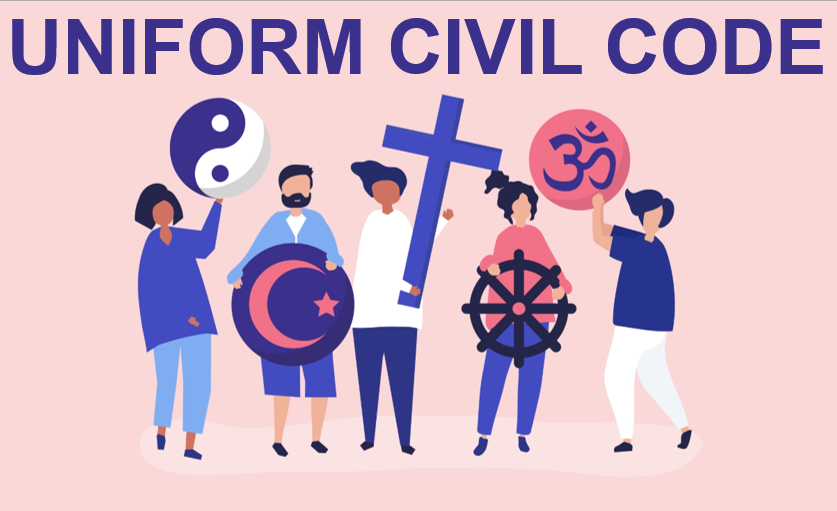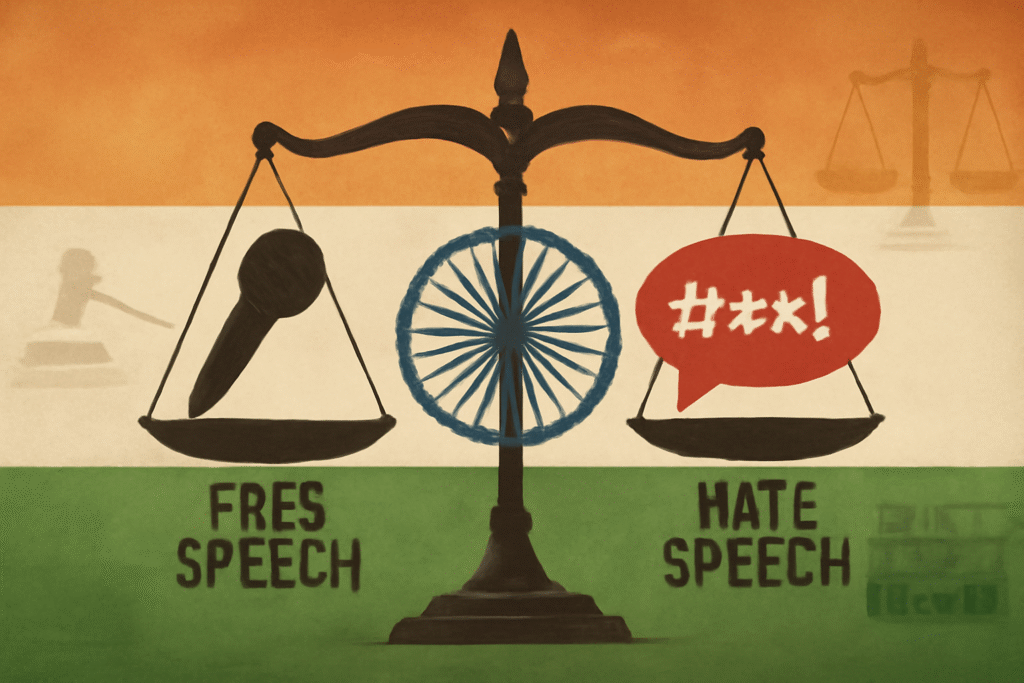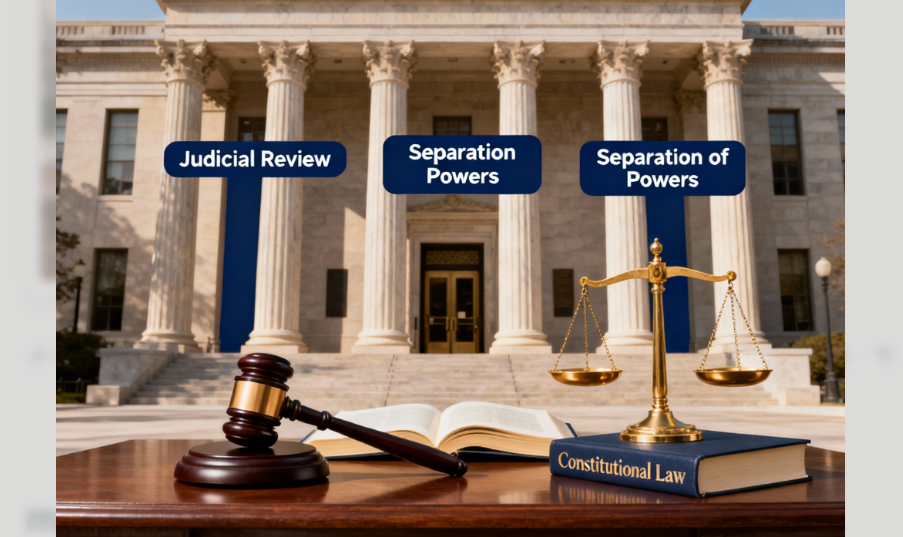Published On: 7th August, 2024
Authored By: Samriddhi Tiwari
Atal Bihari Vajpayee School of Legal Studies, CSJM University
ABSTRACT:
This article inspects the marriage laws prevalent in India. It focuses on the meaning and importance of matrimony in the Indian setup and dwells deep into the ancient background of marriage in Bharat. The research work analyzes the symbolic necessity of conjugal bonds and their functions in society. The study devotes a considerable portion towards the sociological and legal approach to nuptial union. It further explores the 4 basic types of marriage laws in India: Hindu marriage laws, Christian marriage laws, Muslim marriage laws, and Special marriage laws. The analysis not only provides a detailed description of the types of marriages but also uses certain landmark cases to enable the readers to comprehend the changing ideals of marriage in a developing and rapidly growing country. The below-mentioned study details the horrors of child marriage, polygamy, and polyandry and their precarious consequences for the nation. The article not only throws light on the prohibition of the Child Marriage Act and the perspectives regarding homosexual marriages in India. In the end, it also talks about the significance of a uniform civil code in unifying the marriage laws in traditionally diverse India and its assistance in removing copious social evils.
KEYWORDS: Marriage laws, Hindu marriage act, special marriage act, sharia laws, prohibition of child marriage, polygamy, polyandry, uniform civil code(UCC).
INTRODUCTION: MEANING AND IMPORTANCE OF MARRIAGE IN INDIA
Marriage refers to a heterosexual union normally between a man and a woman. Marriage is normally the start of a family. It is a conjugal relation that is regulated by beliefs, customs, and traditions and provides legality to offspring. The universality of marriage depends on various reasons for sexual gratification, the need for affection and care, companionship, procreation, and the division of labor among the different genders. According to societal features, marriage is basically divided into 2 parts: Endogamy (marriage within a boundary ) and Exogamy (marriage outside a boundary). The boundaries of marriage can be anything like caste, religion, gotra, etc. Marriage is a social process which is the reason why marriages performed without any witnesses are deemed to be illegal. Normally, marriages are contract however Hindu marriage is an exception. Muslims have a concept of ‘nikahnama’ while there are licenses given in Christian marriages. It is easier to find the illegality of marriages when they are in the form of a contract as any violation of promise leads to its nullification. That is why, it is important to register Hindu marriages in international scenarios. Marriage is a contract which has primarily 2 forms:
Dowry – It is a social contract.
Bride Price – It is the price paid by the bride to compensate the bride for labor costs.
Marriage is a vital need in society and thence the importance of this nuptial union should be studied. The significance of marriage is as follows-:
- Marriage ensures emotional and psychological well-being.
- It helps in ensuring financial stability.
- Matrimony provides emotional and intimate gratification.
- It is a means of forming a family and raising children.
- The alliance helps in meeting social and cultural expectations.
- Marriage aids in providing legal rights of property and inheritance.
- It helps in building memories and experiences.
- A matrimonial union is a legally recognized conjugal relation.
- It assists in building a strong sense of community and kinship structure.
By studying the aforementioned points it becomes understandable that marriage is a functional necessity. The functions of marriage are:
- Sexual Relation: Any sexual relation before marriage is frowned upon by society however after marriage they are deemed legal.
- Primary Social: The legality of children is dependent on marriage. Children born out of marriage are not provided legal or moral recognition.
- Nurture: In the absence of any rule that says that children should be taken care of by the state or tribe, the responsibility of taking care of children and nurturing them is upon the family.
- Mobility: Mobility refers to movement within society or movement of status within society.
On the basis of mobility, there are specifically 2 types of marriages:
- Hypergamy –When an individual moves vertically upwards in status, class, and caste. {Exception: Race}
- Hypogamy: When an individual moves vertically downwards in status, class and caste.
The argument regarding honor killing and khap panchayat revolves around hypogamy. It must be noted that females are not allowed to practice hypogamy (socially). Men are allowed both however their caste does not change.
BACKGROUND OF MARRIAGE IN ANCIENT INDIA:
The first ever evidence of marriage dates back to 2350 B.C. in Mesopotamia. After that, it was adopted by the Hebrews, Greeks, and Romans. [1]However, earlier marriage was not performed on the grounds of love or religion. It was solely celebrated to ensure that there was no confusion regarding the biological lineage of a man. In ancient Greek, women were regarded as property which was transferred from father to husband. Women were bound to a man to bear offspring and maintain a household. As the Roman Catholic church gained prominence in Europe, the blessing of a priest became necessary and marriage became a religious and sacred societal institution. At the Council of Trent in 1563, the sacramental nature of marriage was written into canon law. The inclusion of religion proved to be beneficial for wives as the men were told to give greater respect to their wives. The bible stated that “the twain shall be one flesh,” which not only solidified the spiritual and emotional importance of the relation between husband and wife but also ensured sexual faithfulness.
The Indian Context:
In ancient India marriage was the most important and sacred ritual. Four purposes of marriage are mentioned in Manusmriti:-[2]
- Progeny
- Fulfillment of desire
- Freedom from parental debt
- Religious work
Sagotra, Sapinda, and Sapravar have been prohibited in Smriti. In the Mauryan period, the age of marriage for a boy was 16 years, and for girls was 12 years. Arthashastra talks about 8 types of marriages-
- Brahma marriage –The marriage that takes place when the bride’s father calls the groom’s family to his house and arranges an alliance.
- Daiva marriage – In this type of marriage the bride’s father used to organize a yagya for taking the permission of gods and whoever was competent enough to perform that yagya was married to his daughter.
- Aarsh marriage – In this type of marriage the bride’s father takes cattle from the groom’s side in exchange for marrying his daughter.
- Prajapatya marriage –The bride’s father used to perform all kinds of social and religious practices before marrying his daughter.
- Asura marriage – When the groom’s family kind of purchased the bride by giving money to her father.
- Gandharva marriage – It was a kind of love marriage where the parents of the couple were not informed.
- Rakshasa marriage – The girl was abducted in this marriage. It was mostly common in Kshatriya culture.
- Paisacha marriage – It was the worst form of marriage where a girl was forced or raped in order to make her agree to the matrimony.
SOCIOLOGICAL AND LEGAL PERSPECTIVE OF MARRIAGE:
Sociological perspective-
According to famous sociologist Iravati Kharvey, the structure of marriage collides with the linguistic structure. Hence there are 4 types of kinship structure that exist in India –
- Northern kinship structure – It is dominated by patriarchal societies where property is transferred to a male heir and patrilocal marriages are common.
- Central kinship structure – The structure is a combination of patriarchal and matriarchal societies. Both patrilocal and matrilocal marriages are common.
- Southern kinship structure – The property is transferred from mother to daughter and the marriages are matrilocal however men are the custodians of property.
- Eastern kinship structure –There is a complete matriarchal structure and marriages are matrilocal in nature.
According to Iravati Kharvey, there are basically two types of marriages-
- Marriage with cousins-Mostly common in Muslim families and parts of southern India. The family tree is small and the property is equally distributed between men and women.
- Marriage not with cousins – It is common in specific parts of northern India like Haryana, UP, and Bihar. The family tree is large and women are kept away from inheritance and property rights.
Legal perspective –
As already stated marriage is a kind of contract hence, a marriage certificate is the only legal document to prove that two adult heterosexual couples are married to each other in India. Any marriage in this nation is registered under the Marriage Act, of 1955. A marriage certificate is a legally recognized document throughout the nation. The honorable Supreme Court in 2006 declared that a marriage certificate is compulsory for all couples. The certificate is needed to apply for a VISA and passport. However, there are certain restrictions to the general rule of applying for certification. The boy should not be less than 21 years and the girl should not be 18 years of age in order to get the marriage certificate.
TYPES OF MARRIAGE LAWS AND THEIR FEATURES:
There are 4 types of marriage laws in India-[3]
- Hindu Marriage Act,1955
As marriage is an integral part of life it must be regulated by law so as to ensure a safe living environment for every household. The Hindu marriage law regulates the marriage of all couples who follow any of the following religions namely Hinduism, Sikhism, Buddhism, and Jainism.
The features of this law are as follows –
- The nature of marriage must be monogamous and if someone wants to marry for a second time then that individual has to show a divorce certificate or death certificate if the spouse is dead.
- The girl must not be less than 18 years while the boy shouldn’t be less than 21 years of age.
- The husband and wife should provide free consent to their unison and they must not be forced.
- If any of the partners is suffering from mental illness then their spouse must give written approval.
- The bride and groom should not be sapindas e. they should not be from the same lineage or bloodline.
Section 5(4) of the act talks about certain conditions under which a Hindu marriage cannot be registered. They are –
- If a boy and girl are of the same bloodline then the marriage is illegal.
- If the bride has previously been married to the groom’s brother or maternal brother.
- Incestuous marriage is prohibited in the act.
Adultery results in a compensation of 10,000 rupees and jail for a month.
Muslim marriage law:
- There is no particular law for Muslim marriage however it is a contract which is governed by ‘nikahnama’
- Like any other contract the status of marriage is achieved by proposal and acceptance (qubool)
- The presence of witnesses from both sides is mandatory.
- According to Sunni laws, the witnesses must include 2 males or 1 male and 2 females.
- Under Shia laws, witnesses are not mandatory in marriage.
- The age limit is different for Shias and Sunnis.
- All marriages that happened after 1981 should be registered under the Registration Act.
Christian Marriage Act,1872:
- .The marriage should be performed under the supervision of the church.
- The bride and groom should be at least 18 years and 21 years respectively.
- The consent should be free.
- The couple should not invite their ex-spouse to the ceremony.
- There must be 2 witnesses.
- Special Marriage Act,1954:
This act allows people of different religions to marry each other without any restraint. The features of this act are as follows:
- Marriage registration is mandatory.
- Free consent and a sound mind of both parties is important.
- The relationships that are somehow connected by blood are forbidden to convert into matrimonial alliances.
- No ceremonies or rituals are conducted. It is carried out in accordance with law i.e. court marriage.
- Neither of the parties should have a living spouse.
SOCIAL EVILS RELATED TO MARRIAGE:
- POLYGAMY –It refers to the practice of marrying more than one wife. Polygamy is an ancient practice that was mainly performed to ensure a strong alliance with other kingdoms and to have as many offspring as possible for a robust bloodline. The harmful effects of polygamy are as follows :
- Mental issues
- Lack of trust
- Jealousy
- Unhealthy marital relationship
Though polygamy is illegal under IPC, Muslims are allowed to have 4 wives according to Sharia law. Besides that, polygamy is a normal practice for many tribes.
- POLYANDRY- When a woman is married to more than one man. The evidence of polyandry is found in historical and religious literature. This practice which has continued to exist for ages has caused various problems like polygamy. Polyandry is illegal in India and is considered a social taboo in several communities however it is still practiced among various tribes like Toda, Kota etc.
3. CHILD MARRIAGE: India has been struggling with the demon of child marriage for decades. In spite of making copious laws and putting endless amounts of effort into demolishing this social evil, we are still not able to eradicate this issue completely. During covid 19 several cases of child marriages were reported throughout the Indian territory.
The Indian legal system protects every child against forced marriages with the help of the Prohibition of Child Marriage Act, of 2006. The key features of the act are as follows. [4]
- It makes all child marriages voidable. Though it does not make the marriage invalid however we must remember that any kind of sexual relationship with a child is a punishable offense under the POCSO Act and section 375 of IPC.
- The act provides maintenance and residence to the girl till her remarriage.
- Any child born out of such marriage is provided appropriate custody.
- Strict punishment is given to offenders. A jail of 2 years or a fine of 1 lakh or both.
- The act allows injunctions to prohibit the practice of child marriage.
SAME-SEX MARRIAGES IN INDIA:
In 2018, the honorable Supreme Court of India gave a historical order to strike down Section 377
This resulted in legalizing the same-sex relationships in India. Though our nation provides legal rights to any couple (homosexual)who cohabits in the form of live-in relationships, it refuses to acknowledge same-sex marriages legally. Since 1980, several same-sex couples have gotten married to each other according to Hindu rituals however their marriages are not registered under the Registration Act and they do not have any legal privilege. In October 2023, the Supreme Court of India declined to legalize same-sex marriages and left the matter to parliament.
Arguments in favor of same-sex marriages:
1. Ensuring equal rights and protection under law.
2. Important for strengthening families and communities.
3. Symbolic of a progressive and pragmatic society.
4. Eradication of conservative and orthodox opinions.
The argument against same-sex marriages:
1. Against religious and cultural beliefs.
2. The purpose of procreation is not fulfilled.
3. It may disrupt the functionality of society.
4. It can cause several legal issues related to property, inheritance, and tax rights.
UNIFORM CIVIL CODE: SINGLE SOLUTION TO VARIOUS PROBLEMS:
In 1985, Shah Bano who was the ex-wife of Muhammad Ahmed Khan demanded maintenance from her husband under section 125 of CRPC after getting teen talaq. The Supreme Court initially ruled in favor of Shah Bano and asked the government to reconsider UCC. However, in 1986 the then government introduced the Muslim Women Protection from Divorce Act 1986 which made Muslim women incapable of getting maintenance after getting ‘mehernama’ or after completion of the iddat period. Hence, the Shah Bano case became one of the most controversial lawsuits in India and provided a fresh start to the debate revolving around UCC.
UCC talks about a single national law regarding marriage, divorce, and inheritance. It aims to replace all religious laws with a uniform law that is pragmatic and just in nature.UCC is important to establish unity in diversity in a real sense and for providing equal opportunities, justice, social and moral protection, and gender parity to every citizen.
Recently, the Uttarakhand government implemented UCC in the state. The implementation of UCC has resulted in the following things:-[5]
- Polygamy is banned in the state.
- A minimum marriageable age limit is set for both genders irrespective of religion.
- Guarantee equal rights to men and women in the cases of divorce.
- Prohibits marriage among relatives.
- Protects the rights of children who are adopted, born out of wedlock, or through surrogacy.
- The bill also makes halala, iddat, and triple talaq – practices governing marriage and divorce under Muslim personal law – punishable offences.
CONCLUSION:
Marriage is indeed a sacred institution that stands on the foundation of love, respect, and companionship. It is the basis of family and plays an important role in ensuring the proper functionality of any society. With the changing times, the concept of marriage has also changed therefore it is vital for the nation to make laws that are progressive and fair in nature as we cannot deny that marriages in India are still not gender-neutral and rely on the patriarchal beliefs and opinions. Therefore, UCC is a need of the hour and a country like India should definitely work on bringing uniformity in civil laws so as to protect the slogan of unity in diversity in its true and letter and spirit.
Reference(s):
[1]THEWEEK,https://theweek.com/articles/528746/origins-marriage#:~:text=The%20first%20recorded%20evidence%20of,Hebrews%2C%20Greeks%2C%20and%20Romans(July 3, 2024)
[2] GEEKSFORGEEKS,https://www.geeksforgeeks.org/marriage-system-in-ancient-era/amp/(July 3,2024)
[3]VAKILSEARCH.COM,https://vakilsearch.com/blog/marriage-laws-in-india/#:~:text=The%20marriage%20must%20be%20a,This%20applies%20to%20both%20parties(July 3,2024)
[4] DOWN TO EARTH ,https://www.downtoearth.org.in/governance/covid-19-poverty-may-have-spurred-child-marriages-in-india-activists-87808(July 4,2024)
[5] BUSINESSSTANDARD.COM,https://www.business-standard.com/amp/finance/personal-finance/explained-how-uniform-civil-code-will-impact-marriage-adoption-inheritance-124020800227_1.html(July 4,2024)




